COOPERATION MODEL
ARTIFICIAL INTELLIGENCE
PRODUCT ENGINEERING
DevOps & Cloud
LOW-CODE/NO-CODE DEVELOPMENT
INDUSTRY
FRONTEND DEVELOPMENT
CLOUD DEVELOPMENT
MOBILE APP DEVELOPMENT
LOW CODE/ NO CODE DEVELOPMENT
EMERGING TECHNOLOGIES







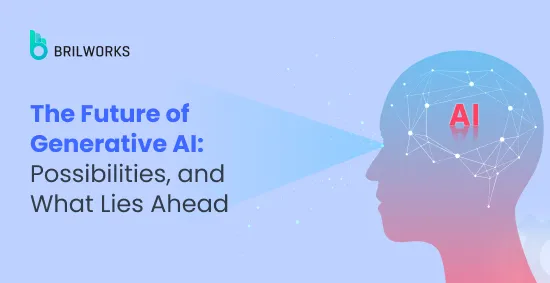
Recent advancements in generative AI, including the development of Generative Adversarial Networks and transformers, have spurred a wave of innovation. These technologies work behind the scenes to help today’s model generate content on par with humans.
In the year 2022, ChatGPT took the internet by storm. It’s been more than a year since the ChatGPT launched and showed the potential of generative AI in business. Since then, business leaders have been busy finding use cases of generative AI in business and testing this technology across different operations.
Basic generative AI modals like ChatGPT and Bard are becoming more powerful and transforming into multimodal tools. The development of smaller LLMs is on the rise. Small businesses are rushing to integrate AI capabilities into their existing digital infrastructure.
Large organizations are moving beyond general-purpose AI applications by developing custom AI solutions. Gartner predicts that by 2027, the adoption of tailored GenAI models within large enterprises will grow from 1% to 50%.
In light of these developments, it is crucial to understand the future of generative AI. To truly understand it, we need to explore its ethical concerns, implementation challenges, limitations, and anticipated advancements.
To truly understand it, we need to explore its ethical concerns, implementation challenges, limitations of generative AI, and anticipated advancements.
By considering all these factors, we can get a better perspective on the future of generative AI. While it has immense potential, it also has a negative side.
A recent example is Meta's suspension of AI development in Brazil. This followed the Brazilian government's objection to Meta's privacy policies related to personal data and AI.
By considering all these aspects, we see that the future of generative AI, while brimming with world-changing potential, also comes with significant threats that we must acknowledge. Taking these factors into account, the future of AI will be shaped by both its advancements and its challenges.
In this article, we will explore some trends and upcoming events in AI development, giving business owners a deeper understanding of the various facets of this popular technology.
Transform your business with cutting-edge AI solutions. We develop custom AI/ML models for startups and mid-sized businesses. Discuss your ideas and challenges with our experts during a free consultation.
Generative AI is a technology that generates various kinds of content. It creates content, including images, text, audio, video, and other types of data. The AI models run on generative AI and can interpret human language, take text, video, audio, and other types of data, and provide results. They can generate original content.
Today, generative AI has applications in almost every field, from content creation to process automation. Some popular use cases and applications of generative AI include marketing, video, and audio generation. Nowadays, almost every content marketer, writer, and platform is using AI in some way.
According to a 2023 report by the Boston Consulting Group, over 70% of Chief Marketing Officers (CMOs) are actively experimenting with generative AI, focusing on areas such as personalization, marketing operations, and innovation.
Here are the most popular applications of generative AI:
You have a lot of customer data; generative AI can help. This technology excels at analyzing a massive amount of data. In your case, it could be customer data and preferences. AI can process this data at a blazing-fast speed and in record time, helping you create targeted marketing messages.
You can leverage generative AI for content creation as it can write compelling product descriptions, ad copy, social media content, and variations to test and optimize content and website landing pages for maximum conversion rates.
Generative AI can transcribe audio or video recordings of meetings and then summarize the key points, action items, and decisions taken.
In the healthcare industry, professionals spend a significant amount of time communicating with patients and even more time on administrative tasks. Generative AI tools in healthcare proove to be very useful in note-taking.
Professionals can save a lot of time summarizing conversations that took place during meetings. With the help of these tools, you can enhance your work culture. Tasks like note-taking, which used to take hours, can now be done instantly.
Tasks such as video editing and creating special effects are now much easier with the help of AI. The way AI technology is evolving, it will likely be able to generate entire videos from scratch, based on a script or storyboard. This could revolutionize the way videos are produced, making it faster and more affordable.
AI tools for website and software development can significantly reduce developers' time. If we were to say that today's AI tools can develop websites, it might be an exaggeration, but yes, they can indeed reduce developers' efforts and time to a considerable extent in software development.
In software development, AI can work along with developers in some areas such as automation of code generation like generating boilerplate code, as well as code analysis and optimization, and error detection.
For example, popular no-code/low-code tools have become even more powerful with AI capabilities. This has led to significant advancements in no-code/low-code development, improving efficiency in various ways.
In the past two years, we've witnessed an evolution in popular generative AI modals, transitioning from unimodal to multimodal capabilities. These models can now process information from a variety of sources, not just one. They can understand and interpret text, audio, images, and videos. Popular generative tool Gemini can now interpret visual contents too. GPT-4o mini now supports text, audio, video inputs and, outputs too coming in the future.
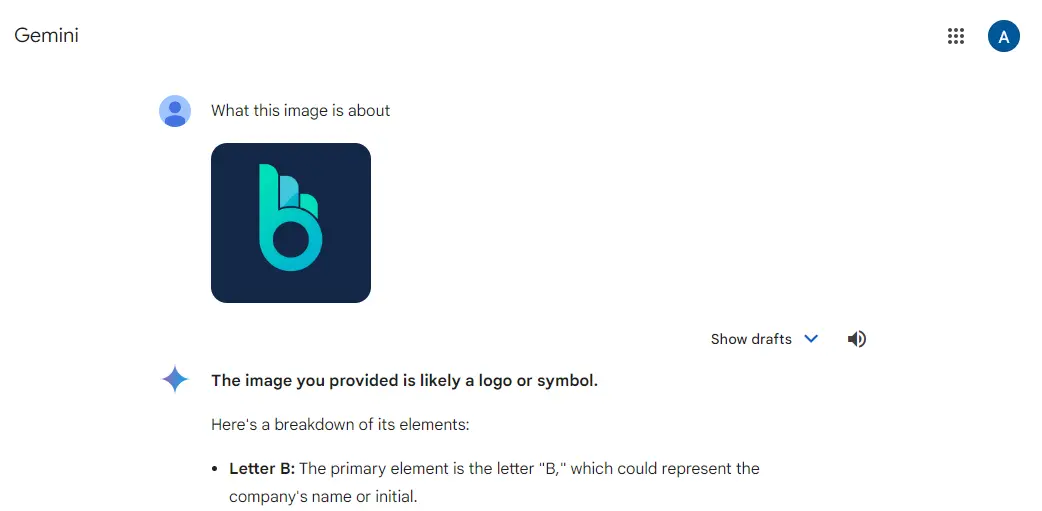
Multimodal development is expected to accelerate in the coming years. While early models were primarily text-based, the rise of multimodal AI tools will enable these assistants to go beyond textual interactions.
From healthcare and finance to customer experience, these models are in high demand. According to Grand View Research, the multimodal AI market is projected to grow at a compound annual growth rate (CAGR) of over 30% until 2032.
AI development companies are finally looking for smaller LLMs. Large Language Models (LLMs), which work behind the scenes in today's popular chatbots, have very large parameters, containing billions of them. However, these are beyond the capabilities of most companies to create. Maintaining smaller LLMs is affordable for companies, and it is also easier to operate them.
There is a significant gap between the performance and functionality of commercially available AI models and open-source models. However, due to the cost of generative AI, Open-source generative models are becoming popular. In 2024 and beyond, we can expect to see improvements and advancements in open models.
This collective effort will accelerate the pace of innovation in AI.
In the near future, the world of artificial intelligence is about to change dramatically. What used to be a playground only for big tech companies and scientists is now becoming more and more accessible.
This is happening because of the increasing popularity of open-source AI development. This trend is not just making AI available to everyone, but it's also speeding up how fast we can create new AI things and making AI feel less like magic and more like something we can understand.
The future of generative AI heavily depends on the evolution of generative AI development. If we look at current trends, the development of task-specific AI models is progressing rapidly. Large organizations are already engaged in tailoring AI models to specific tasks.
By 2027, more than 50% of the GenAI models that enterprises use will be specific to either an industry or business function — up from approximately 1% in 2023. - Garter Report
However, if we look at current models, their cognitive and automation potential is quite limited. Most modals designed to solve specific tasks such as answering questions, product recommendation excel at these tasks, but still struggle in understanding complex and nuance interactions.
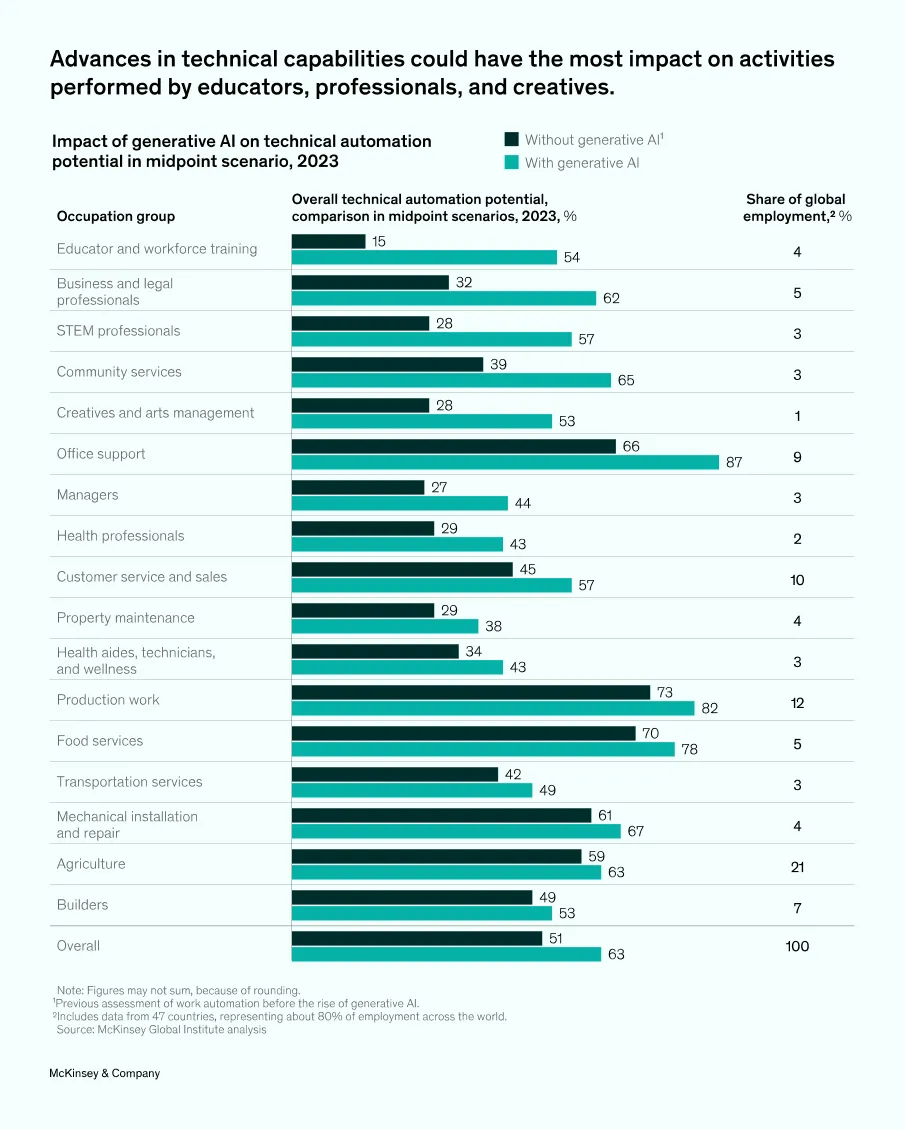
As AI becomes more accurate, efficient, and reliable businesses and individuals may become irresistible from implementing its use in their work. Different industries will start to adopt it as a tool to enhance their work productivity, cost efficiency, and time consumption.
Let’s look at how different industries will be impacted by the future gen AI.
Generative AI in healthcare will accelerate diagnosis for the patient as it can analyze vast amount of medical data precisely. This will also help healthcare organizations deliver more personalized medications and therapies. AI can analyze vast datasets to accelerate the discovery of new drugs and even predict potential side effects, ensuring safety for human consumption.
Generative AI presents a paradigm shift in data analysis, particularly within the financial sector. Its ability to process massive datasets in mere minutes promises to streamline cumbersome numerical tasks.
Financial institutions will leverage this technology to generate comprehensive reports, potentially identifying lucrative investment opportunities that may have been previously overlooked.
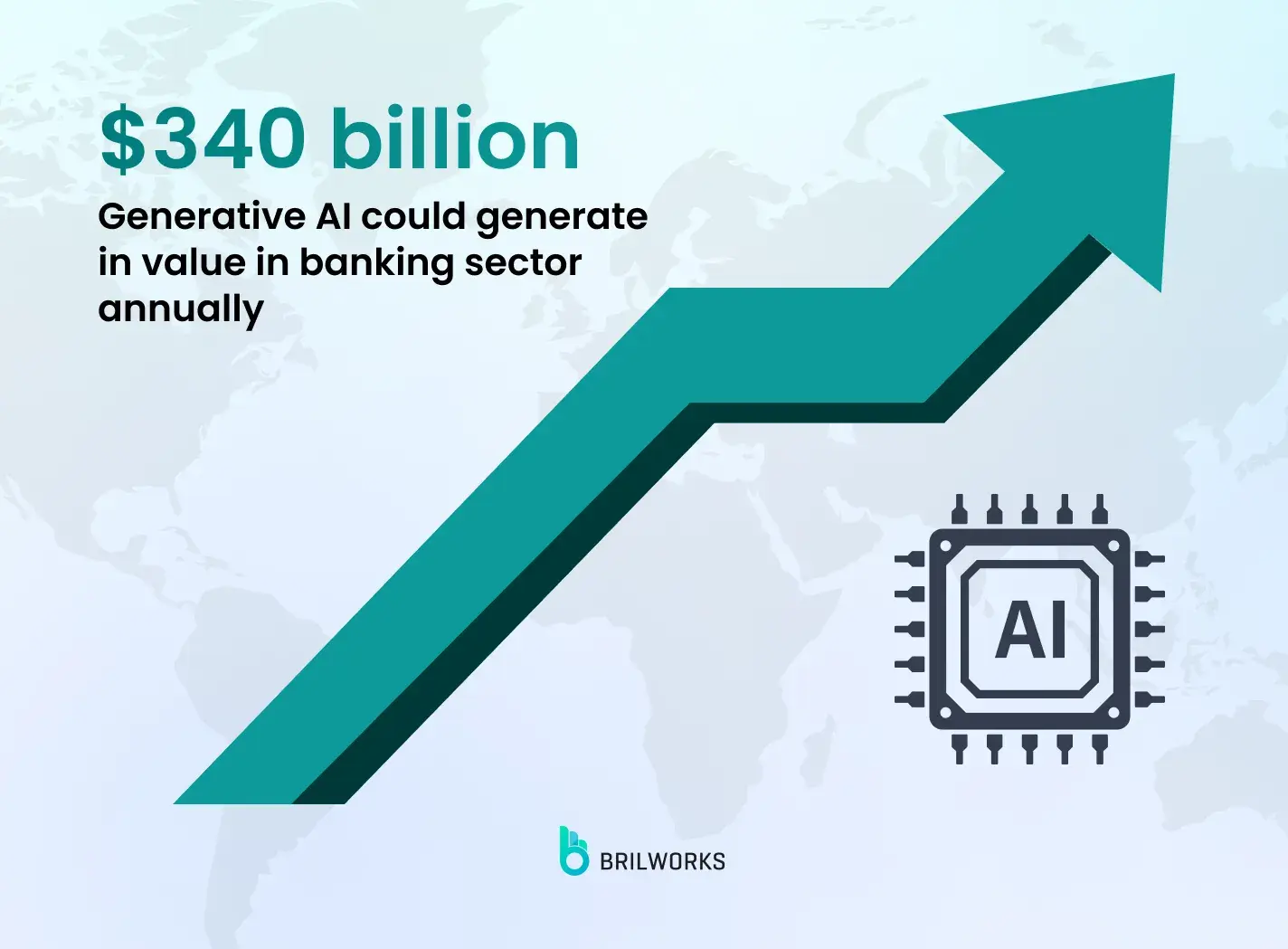
Furthermore, the implementation of AI chatbots within banks signifies a move towards enhanced customer service. These chatbots can efficiently handle account inquiries, and loan applications, and even offer basic financial planning assistance.
AI is set to change education by offering personalized learning experiences tailored to individual student needs. Through advanced algorithms, AI will analyze students' learning patterns and preferences, allowing for adaptive learning platforms that adjust content and pace accordingly. Virtual tutors powered by AI will provide real-time feedback and support, enhancing traditional teaching methods.
Generative AI can function as a creative partner. In this industry, providing personalized content has been the biggest challenge, but AI has greatly alleviated this issue. AI technology can monitors user behavior and patterns continuously, aiding business owners in optimizing content delivery, improving recommendation algorithms, and identifying target audiences.
As with any powerful tool, AI comes with a double-edged sword. While it promises to revolutionize work, making tasks faster and less time-consuming, concerns about its responsible use are mounting. Threats such as deepfakes, which blur the line between reality and fabrication can be used to create life-like content from images to videos such power can be used to spread misinformation and manipulate the public.
Additionally, using AI for content creation can lead to some copyrighted legal battles, especially in the music industry where AI creates music that closely resembles the copyrighted music of the original artist.
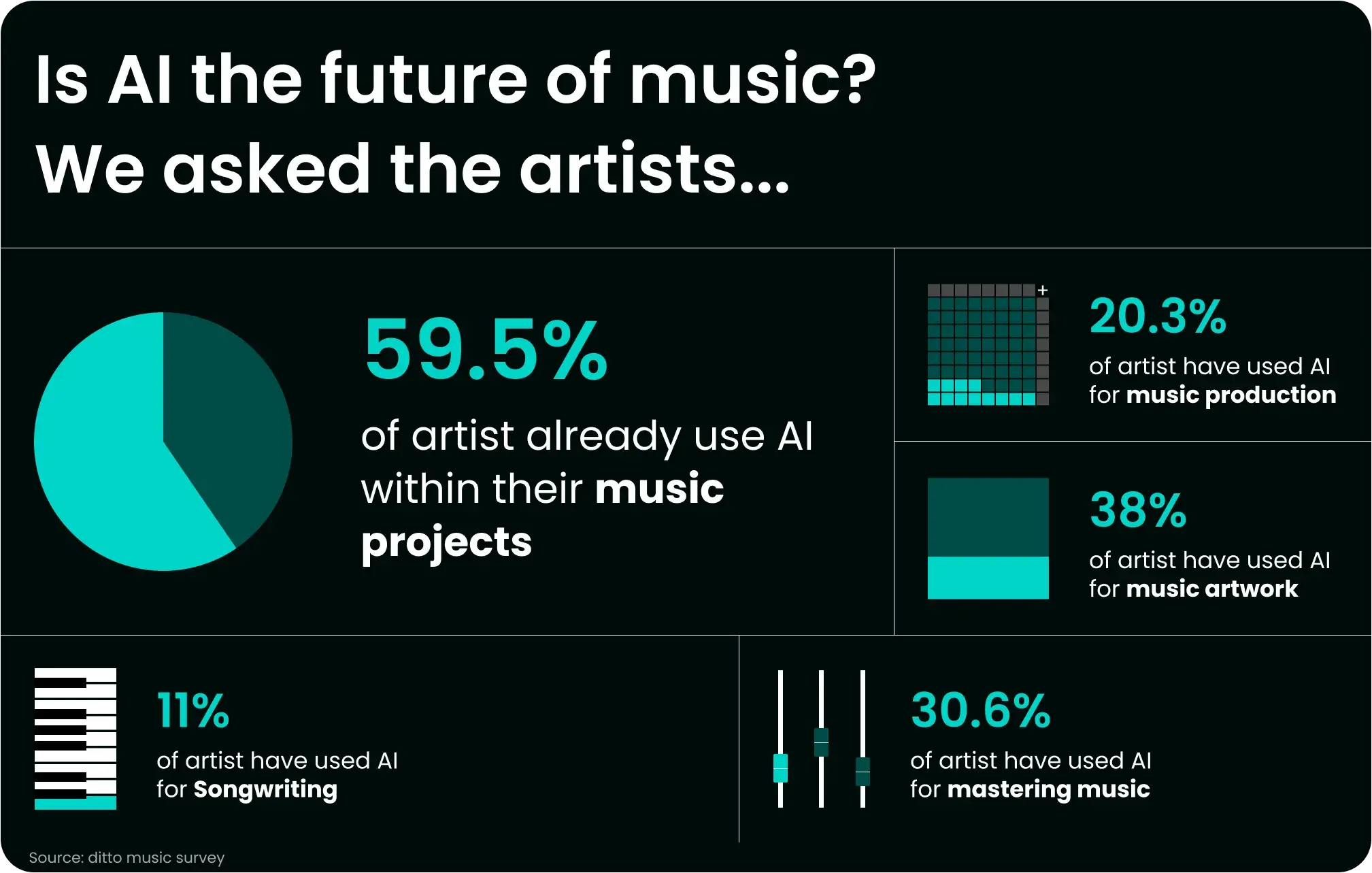
Because of these Ethical concerns ongoing dialogue has been taken into account by the government. The current opacity of some AI models raises concerns about accountability and bias. Future AI development will prioritize explainability, allowing humans to understand the reasoning behind AI decisions.
AI algorithms can perpetuate societal biases present in their training data. The future prioritizes identifying and reducing bias in AI for fair treatment. Regulations will be built requiring AI systems to provide clear explanations for their outputs, empowering users to trust and assess the fairness of AI-driven decisions.
Generative AI could really pump up the global economy, potentially adding trillions of dollars to GDP. According to a report by McKinsey, it could create annual value between $2.6 trillion and $4.4 trillion, which is more than the entire GDP of the UK in 2021, which was $3.1 trillion. This translates to a 15-40% boost in the overall impact of artificial intelligence.
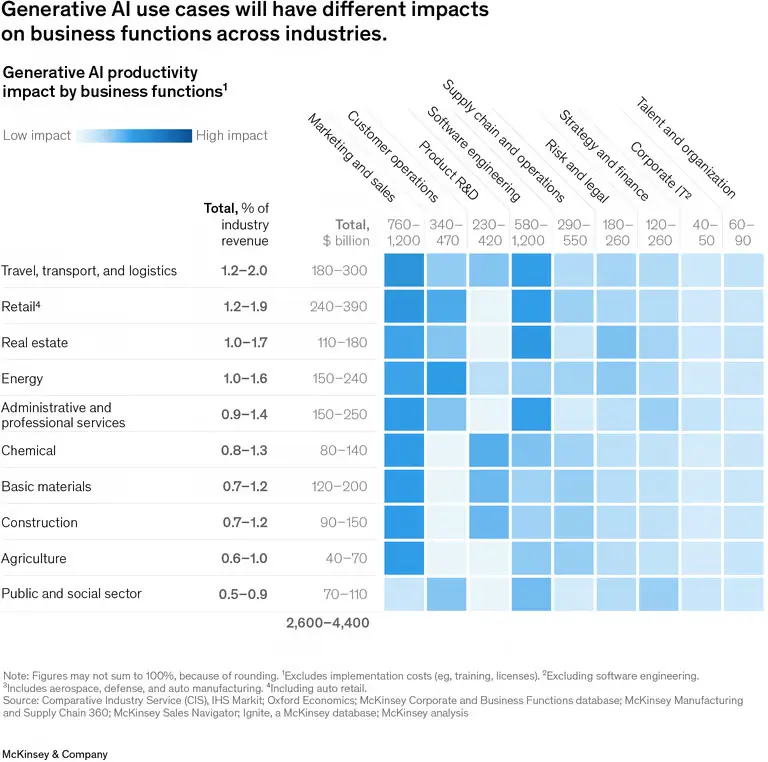
Generative AI holds immense promise for the future across various industries, promising exceptional levels of productivity, efficiency, and innovation. As this technology continues to advance, it will reshape how businesses operate.
Adopting Generative AI represents not just a technological advancement, but a more liberating creative expression towards art. While challenges remain, like ensuring responsible development and addressing potential biases, the vast potential benefits outweigh them. In making sure that Generative AI technology not replacing humans but enhancing human capabilities, we can use this cutting-edge technology for the betterment of society.
Every technology has two aspects. How powerful AI will become and whether it will replace human creativity is a matter of future discussion. However, it is certain now that using this technology, business owners can streamline many operations. If you have an idea, we are happy to turn your idea into digital reality with our expert AI/ML development services. As a top-rated AI development company, we offer cutting-edge generative AI software development services."
Generative AI is a type of artificial intelligence that can create entirely new content, like text, images, or code. It learns by analyzing massive amounts of existing data, identifying patterns, and using them to produce novel outputs. Imagine a painter who studies countless works of art and then creates their own unique masterpiece.
Generative AI is already making waves in various fields. In marketing, it can craft personalized ad copy or product descriptions. In drug discovery, it can design new molecules to combat diseases. Even creative industries are embracing generative AI, with applications like composing music or generating new artistic styles.
While generative AI can automate some tasks, it's unlikely to replace most jobs entirely. Instead, it's expected to become a powerful tool that assists humans in various fields. Imagine a writer using generative AI to brainstorm ideas or a designer leveraging it to create variations on their concepts.
Get In Touch
Contact us for your software development requirements
Get In Touch
Contact us for your software development requirements